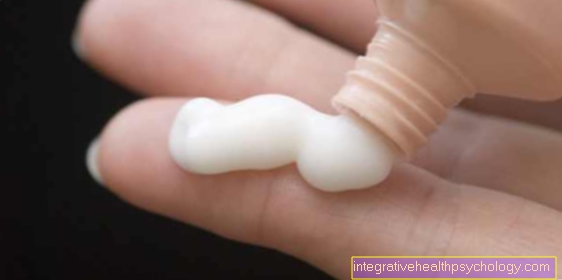Boils on the thigh
DEFINITION
A thigh boil is defined as bacterial inflammation of a hair follicle in the thigh area. The thigh is a typical, preferred location for the development of a boil. In technical jargon, a predilection point is used.
A boil can be felt as a heated, reddened, painful lump on the thigh. The neighborhood tissue is also often affected. If several boils are next to each other on the thigh and merge with one another, it is called a carbuncle. If such a boil appears again and again on the thigh, the medical jargon describes this as a furunculosis, the cause of which should definitely be clarified by a doctor.

CAUSES of a boil on the thigh
The causes of a boil on the thigh can be many. Condition for the development are injuries to the hairy thigh skin. Bacteria can penetrate through visible skin damage as well as inconspicuous injuries. Various bacteria can be the cause here. As a rule, these are so-called staphylococci. Often it is Staphylococcus aureus. Most staphylococci belong to the healthy, normal skin flora and have no general disease value. Only under certain conditions do they multiply and cause bacterial inflammation. This can lead to such a boil.
The bacteria penetrate the injured skin along a hair follicle. A deep, inflammatory infiltration then occurs within a few hours to days. An uncomplicated boil bursts on its own after about a week. The pus then drains, relieving the boil and allowing it to heal. At the end of the healing process, a small scar usually remains.
The development of small injuries on the thigh and thus the development of the entry port for the bacteria can be promoted by friction, increased sweating, tight-fitting or chafing pants. In addition, the risk of developing bacterial inflammation is greater in people with a weakened immune system, such as those with diabetes (diabetes mellitus).
Also read: Causes of a boil
DIAGNOSIS of a boil on the thigh
At the beginning of every examination there is the questioning of the person concerned or the relatives, if the patient is not able to express himself adequately. In the technical language, personal and external anamnesis is used.
In the case of a boil on the thigh, these anamneses can provide important clues as to the cause of the development. It is helpful if the patient or their relatives think about which information is important for the doctor before they visit the doctor. Answering the W questions (what, how, when, where, etc.) can be helpful.
After taking the anamnesis, the doctor will look at and feel the affected area. The general skin condition and the patient's appearance are also considered holistically. If the boil is open, a smear is taken to detect the pathogen. If boils occur more frequently, the blood sugar level and possibly other parameters in the blood are measured.
Read more about diagnostic procedures for boils under: Blood glucose test
SYMPTOMS of a boil on the thigh
As a rule, a boil on the thigh shows the classic signs of inflammation: reddening, warming, swelling and pain. Most of the time it is pressure sensitive and elastic. If clothing rubs against the boil, it can be painful when moving in any way or at rest. If you look closely, you can see a hair in the middle.
Pus can escape from a ripe boil. The pus is usually yellowish and can sometimes smell unpleasant. In the case of more severe courses, a weakened immune system or underlying diseases that are accompanied by an immune deficiency, a general feeling of illness, fatigue, fever, chills and other flu-like symptoms can also occur. This is less common but should be taken seriously as a fever is a sign that the bacteria have entered the bloodstream. This implies the risk of blood poisoning. In this case, it is imperative to seek medical treatment immediately.
In principle, complications with thigh boils are rare. However, when they do occur, rapid and adequate therapy is required. Emergency medical help is required if drowsiness, circulatory failure or shock occurs.
Also read: Pus under the skin
Localization of the boil
inside
The inside of the thigh is exposed to permanent friction. This happens both through clothing and through unconscious or conscious movements in walking, standing, sitting and lying down.
Therefore, the inside of the thigh is an exposed part of the body for the development of a "boil". In addition, increased body weight and / or increased sweating promote the development of a boil on the inside of the thigh. In addition, an unstable, dry skin texture predestines the development of injuries. This increases the risk of bacterial inflammation. Certain pre-existing skin diseases also promote the occurrence of a boil.
Also read: Boils on the leg
Back
Due to the combination of pressure and friction in a sitting or lying position, the posterior thigh is also exposed to the development of a boil. The conditions of development, risk factors, discomfort and treatment are similar to the boils that are localized in other parts of the thigh.
THERAPY of a boil on the thigh
How to remove the boil on the thigh
If the boil does not burst open and the pus does not evacuate on its own, an operation for a boil is sometimes necessary. This means that a doctor has to make a so-called stab incision. Often this operation can be performed under local anesthesia. As a rule, it is a minor intervention. The doctor opens the boil with a scalpel so that the pus can escape.
Only in rare cases does this procedure have to be performed under general anesthesia. The patient is informed in detail about the anesthesia in writing and orally. There is a follow-up treatment with antiseptic and antibiotic ointments. The patient is instructed how to care for the wound. In addition, the wound should not be stressed and pressure and friction on it should be avoided as far as possible. If bacteria have spread into the lymphatic and blood systems, antibiotics must be given in tablet form or as an infusion.
In the case of increased thigh furuncles, the cause or underlying disease must be treated in addition to the surgical intervention. Furthermore, in some cases the antibiotics clindamycin and rifampicin in particular are prescribed for 2-3 weeks and possibly, in the case of immune deficiency, specially dosed vitamin C is prescribed.
Are you interested in this topic? Read our next article at: Boils on the leg - how it is treated
Pull ointment for a boil
With smaller, not yet melted boils on the thigh, a pulling ointment can sometimes have a supportive effect. Pull ointments have anti-inflammatory, analgesic, antipruritic, blood circulation-promoting and sebum-reducing properties. As the name suggests, they pull the pus out of the boil and relieve it so it can heal.
As a rule, the pull ointments are made from oil shale and, more rarely, on a plant basis. Most often they contain ammonium bituminosulfonate (Ichthammolum).
Also read: Ointment for a boil
HEALING DURATION of a boil
The duration of a boil on the thigh correlates with the size and the body's own defense system. In addition, individual factors often play a major role in the healing process.
- With a small boil, a good immune system, good hygiene, and uncomplicated circumstances, a boil can heal completely in a few days. This usually leaves a small scar.
- In adverse conditions and with a weakened immune system, the boil can sometimes take weeks to heal. If complications arise, the healing process may take months.
Also read: Duration of a boil
Boils in pregnancy
Due to the hormonal changes during pregnancy, a boil can develop in some cases. This can be related to a changed complexion or / and a weakened immune system.
In addition, when you gain weight, there may be increased friction and sweating in the inner thighs. This can encourage the development of boils. If such a boil develops during pregnancy, a doctor should be consulted as early as possible. This then decides on possible treatment measures within the framework of a benefit-harm ratio.





























